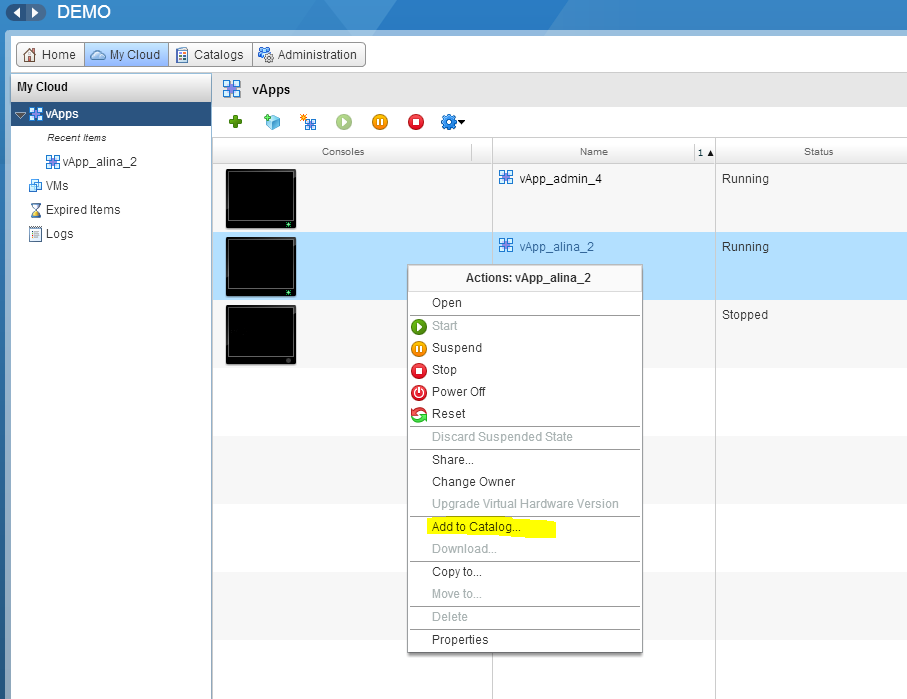Configure the networking options for the vApp. This operation requires the rights included in the predefined vApp Author role or an equivalent set of rights. Type the hard disk space for the vApp's virtual machines or leave this section unchanged to use the template's default hard disk configuration. A vApp template must be available in a catalog in your organization. You can access vApp templates in your organization's shared catalogs or, if you are an organization administrator, from a public catalog. Right-click a vApp and select Add to Catalog. Select Overwrite catalog item if you want the new catalog item to overwrite any existing vApp Template that has the same name.
| Uploader: | Malalmaran |
| Date Added: | 10 January 2005 |
| File Size: | 16.23 Mb |
| Operating Systems: | Windows NT/2000/XP/2003/2003/7/8/10 MacOS 10/X |
| Downloads: | 42836 |
| Price: | Free* [*Free Regsitration Required] |
The default storage lease is configured by your organization administrator.

If you select this option and guest customization is enabled, the guest operating system is personalized. You can add a vApp template from a catalog as a vApp in My Cloud. You can access vApp templates in your organization's shared catalogs or, if you are an organization administrator, from a public catalog.
Specify a Storage lease. Review the vApp summary information and click Finish. Your organization must have a catalog and a virtual datacenter with available space. Guest operating system is personalized regardless of the vApp template settings when the template is instantiated.
This operation requires the rights included in the predefined vApp Author templste or an equivalent set of rights. Optional Select Power on vApp after this wizard is finished to power on the vApp after vApp creation is complete.
Option Description Make Identical Copy. Select the storage policies for the vApp's virtual machines to use when deployed from each virtual machine's drop-down menu. Type the amount of memory for the vApp's virtual machines or leave this section unchanged to use the template's default memory configuration. Type the hard disk space for the vApp's virtual machines or leave this section unchanged to use the template's default hard disk configuration.
Add a vApp Template to My Cloud
IP addresses of the NICs in the template are reserved. Select runtime and storage lease duration from the drop-down menus. A vApp template must be available in a catalog in your organization. In the left pane, click a catalog option. Type a Name and optional Description for the vApp template. Specify how the template should be created.
Type a name and optional description for the vApp. If you select a running vApp, it is added to the catalog as a vApp template with all of its virtual machines in a suspended state.
Create & Manage vApp Templates - OnApp and vCloud Director Configuration Guide
The vApp is saved as a vApp template and appears in the specified catalog. In the left pane, click vApps. If any of those properties are user-configurable, you can specify the values. Type the number of virtual CPUs and cores per socket for the vApp's virtual machines or templat this section unchanged to use the template's default virtual CPU configuration.
Create & Manage vApp Templates
You can save a vApp templats a catalog as a vApp template. Optional Configure vApp hardware settings. This operation requires the rights included in the predefined vApp Author role or an equivalent set of rights. IP addresses of the NICs in the template are released.
Select Overwrite catalog item if you want the new catalog item to overwrite any existing vApp Template that has the same name. Select a virtual datacenter to add the vApp to.
Making a vCloud multi VM vApp template
vvcloud Configure the networking options for the vApp. If the vApp template is based on an OVF file that includes OVF properties for customizing its virtual machines, those properties are passed to the vApp.
Right-click a vApp and select Add to Catalog.

No comments:
Post a Comment